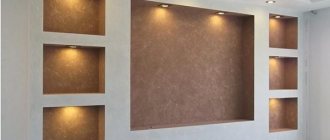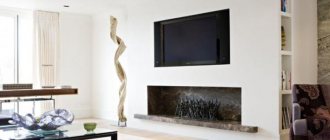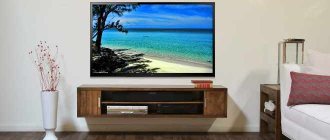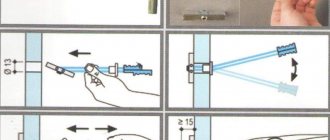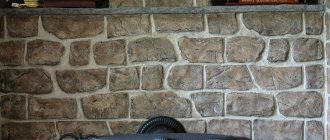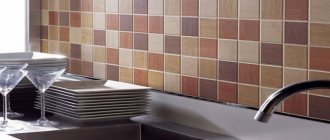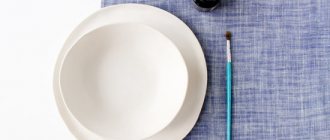TV niche made of plasterboard
Modern technologies allow the most productive use of room space. Even niches that seem impossible to find a use for can be easily converted into useful shelves, racks, etc. Moreover, in the arsenal of designers and builders there is a universal material that will remain almost invisible in the interior, but very functional.
We are talking about drywall, the properties of which allow this material to be cut, fastened, painted, etc. This makes it possible to install household appliances in wall niches and thereby free up space in the room. This is especially convenient if the size of the space in the wall coincides with the size of the TV, home theater, etc., because most often such equipment is installed in the living room - a room where there is always little space.
You can make a niche for a TV from plasterboard with your own hands, having first studied all the intricacies of installation, fastening and design. Below we will tell you what to pay attention to when creating such a design and how to make it as beautiful and aesthetically pleasing as possible.
Niche design options
Arranging beautiful portals for TV, home theaters, multimedia systems is an excellent solution for repeatedly transforming the design of the interior decoration of living rooms, bedrooms, halls and even hallways. The financial side of the issue is not a problem here. The costs of purchasing materials, organizing and carrying out work here are minimal.
The kitchen space or dining room primarily involves compact and functional recesses finished in the form of laminate panels.
Judge for yourself - the cost of one sheet of plasterboard is 100 rubles for a standard cutting of 1500 * 600 * 12.5 mm. And this includes delivery. And when purchasing a large volume, the manufacturer usually gives a good discount.
You can make beautiful architectural solutions from plasterboard sheets. For example, arranging a recess for an aquarium next to your TV. Designing all sorts of decorative objects, be it a hole in the wall for installing a family photo or a place for placing a lush flower in a pot, is not difficult.
Decorative stonework is a natural object with an inimitable texture that becomes a wonderful addition to any design.
An additional arrangement of spotlights in the wall portals will ensure excellent well-being, uplifting your mood and life priorities, just by looking at such decor.
Arranging the edges with all sorts of decorative materials will give the interior design a completely different look. For example, organize an apartment mixborder. To do this, cover the protruding parts of the edges with tiles made of natural stone. If you want to save money, use substitute materials. Unique room decor in modern times is an affordable idea.
This finish allows you to add a certain rigor and reliability to the interior.
Have you always wanted to have a fireplace, but live in the city? No problem. Assemble an improvised chimney from plasterboard slabs. Visit a hardware store. There are often amazing finishing materials that imitate natural stone. This design will definitely not leave you indifferent.
An ecological fireplace will brighten up your home comfort. This is a device that simulates the burning of a real flame. For city apartments this is an ideal option. Above the fireplace there is a suggestion for installing a TV. Thanks to special fasteners for gypsum boards, such as “Harmut”, “Butterfly”, etc., you can hang the TV directly on a plasterboard partition.
A TV in a niche in combination with an electric fireplace, bio-fireplace or false fireplace looks very beautiful, sets the desired mood for the interior and makes the atmosphere much more comfortable and cozy.
Use gypsum boards when creating unique architectural compositions covering the entire wall. Make majestic arches, the portal of which is lined with rough cobblestones of natural stone. Organize lighting in specific areas. Also, install an LED strip around the entire perimeter.
At night, when such a composition is turned on in the network, the apartment will be illuminated by a true glow of superiority. This design will make you stand out as a connoisseur of extraordinary design, which is not so easy to come across these days.
Thanks to well-placed additional lighting, the space not only becomes much brighter and lighter, but also noticeably transforms.
What is drywall: advantages and disadvantages of the material
Working with plasterboard is quite simple due to its structure: this finishing material consists of two elements: a layer of gypsum and specially treated cardboard , which covers the gypsum core on both sides. This allows you to protect the plaster from external factors. In addition, thanks to the perfectly flat surface, the material does not require additional processing before installation and processing.
In addition, the adhesive composition and foam used to produce gypsum are ideal for use in interior decoration: the material does not affect human health, and fumes do not pollute the air . Another important property of drywall is its ability to absorb moisture when there is excess and release when there is not enough. Among the main characteristics that are valued in construction:
- flexibility;
- ease;
- the ability to decorate;
- strength;
- wear resistance.
Shapes and sizes of niches for TV
The choice of shape and size primarily depends on the characteristics of the room being designed and its style.
- Corner. It does not clutter up the space and allows you to rationally use the corner, which is especially suitable for a small room.
- Rotary. It is quite an expressive interior accent and, due to the rotating system, makes it very convenient to use.
- Under the stairs. A niche well-fitted into the space can take a central place in the design of the room, relegate the staircase to the background and make the structure less cumbersome.
- The entire wall. With the help of a recess across the entire wall, it is possible to effectively fill the space. However, this decorative technique is more appropriate for spacious rooms.
- Rounded. A round or semicircular shape significantly softens the atmosphere, smoothes and ennobles the architectural rectangularity of the space.
Positive and negative properties of drywall
Like any building material, drywall has its strengths and weaknesses. The latter include:
- budget - compared to stone, plaster or wood, the cost of plasterboard is relatively low, and this allows it to be used for finishing large areas and creating different structures;
- ease of transportation - sheets of plasterboard are easy to transport: they have a standard size, which makes it possible to fit the material into a car, and also weigh a little, which makes it easy to use them even on upper floors;
- installation speed – due to the absence of “dirty” work (mixing special solutions, gluing, etc.), drywall is quickly and easily attached to the base. In addition, the surface of such a finish is already smooth - it is easy to putty, paint or paste over;
- versatility - due to the fact that plasterboard can be cut and “customized” to fit, it can be used for various purposes: from creating multi-level ceilings to small structures in the form of niches, shelves and racks;
- safety - drywall stabilizes the humidity level in the room. In addition, the material does not burn .
As for the disadvantages of plasterboard , here we can highlight the ability to get wet and, as a result, deformation, as well as fragility: if you hammer a nail into a plasterboard sheet, it will not withstand a heavy load.
Installation of the frame and covering it with plasterboard
In most cases, the back surface of the niche is the base wall, so all that remains is to build a frame for the protruding parts of the portal.
- Markings are made on the wall, ceiling and floor according to the drawn up project. The optimal distance between vertical profiles is 60 cm.
- Guide profiles are attached. They are attached to concrete surfaces using dowel nails, and to wooden surfaces using wood screws. The use of damper tape is mandatory. The fastening pitch should be 20–25 cm.
If you need to bend the profile, you should cut its side flanges with metal scissors, after which it will easily take the required shape.
- Vertical posts are inserted into the guide profiles. They can be secured using “fleas” - small metal screws. But it’s better to use a cutter: the screw heads can prevent the drywall from fitting tightly to the profile.
- The required number of horizontal jumpers is installed in all planes. They provide structural rigidity.
At all stages of frame construction, the position of the profiles should be monitored using a level and square.
- Drywall cut according to templates is fastened. The screws are slightly recessed into the material.
- The rough finishing of a niche is no different from the standard finishing of plasterboard structures: the surface of the assembled niche is primed and puttied, joints and corners are reinforced with reinforcing tape, and the outer edges are reinforced with perforated corners.
After the putty has dried, finishing work can be carried out according to the chosen niche design.
Do-it-yourself TV niche: choosing a design
Just a few decades ago, a niche was a place that was specially hidden from the eyes of house guests. Usually unnecessary rubbish was placed there and hung with a decorative curtain or closed with doors. However, today this situation can be corrected and with the help of drywall, you can turn this space into a stylish and beautiful place for a TV or multimedia equipment. Before you start creating the structure, you need to decide on the place where it will be built, as well as on the design.
It should immediately be noted that the niche should be installed taking into account all the subtleties:
- calculate how the audio system will be installed: the subwoofer, speakers and sound amplifiers should not be covered;
- calculate the comfortable height at which the screen will be installed. To do this, you should take into account the height of the proposed niche, the distance to the sofa/bed, as well as the height of the furniture. It should be noted here that experts recommend making a niche at a distance of at least 3 meters from the person;
- Before installing drywall parts, you should think through and cut out all the connectors for the wires in advance.
The design of the niche itself should not stand out from the overall ensemble of the room. This space should be inconspicuous and should not attract unnecessary attention, because the main purpose of a niche is to provide additional functionality.
Therefore, it would be best to make it plain, or with an imitation of natural material, if we are talking about using stone, wood or other species in the interior.
Design ideas around the TV
Design options for the area around the TV device.
With shelves
A variety of shelves are a very common decor option. They can be decorated with books, photo frames, decorated with flower arrangements, figurines, or various equipment can be conveniently placed on them.
TV and fireplace
A TV in a niche, in combination with an electric fireplace, bio-fireplace or false fireplace, looks very beautiful, sets the right mood for the interior of an apartment, country house or cottage and makes the atmosphere much more comfortable and cozy.
Backlit
Thanks to well-placed additional lighting, the space not only becomes much brighter and lighter, but also noticeably transforms. In addition, the backlight favorably highlights and focuses attention on the TV screen.
With stucco
This decor gives the design special respectability and aristocracy. Plasma, recessed in stucco patterns, will become an incredibly presentable element of the room.
The photo shows a living room in the Art Nouveau style with a TV located in a niche decorated with stucco.
With speakers
Such a recess not only represents the center of the whole composition and is a full-fledged design element, but also provides the opportunity to hide wires and harmoniously fit speakers and all the necessary equipment into the space, without destroying its visual component.
Aquarium
Adds individual character to the environment and becomes a real living picture, giving the final aesthetic touch to the entire design.
Creating a sketch and calculating dimensions
Once the decision has been made about where the niche will be located, what elements it will consist of and what the height of the structure will be, you should proceed to developing sketches. At this stage there are several important points to consider:
- draw all the metal profiles that will be used in the structure, taking into account the thickness of the material and the installation of additional jumpers that will strengthen the structure;
- indicate on the diagram where the sockets will be moved and how they will be attached;
- outline ways to divide drywall to the desired size and shape, which would save the amount of material.
The dimensions greatly depend on the diagonal of your equipment and the need to install an audio and video system. Leave at least 20 centimeters from the TV on the right and left sides. Otherwise, there is a risk of equipment overheating and failure.
Finishing
I would not like to stop at this stage of work, because everyone must decide for themselves what to cover the created structure with. However, there are certain details that you should definitely pay attention to:
- joints, except corner ones, are undesirable. Therefore, it is necessary that each part of the structure being created is sheathed with a single sheet. Having straight drywall joints can lead to cracks in the future. To avoid this, you will have to chamfer, use reinforcing tape and the correct technique for filling joints;
- all corner joints must be protected with a reinforcing corner (there are plastic and metal); the corners are placed on putty;
- a niche created from plasterboard for a TV is completely treated with starting putty;
- the dried starting putty is treated with sandpaper, primed, and then a thin layer of finishing putty is applied;
- The dried layer of finishing putty is processed as desired.
You can learn about creating more complex structures from the video.
The most popular types of TV niches
People who want to create a plasterboard structure for television equipment must choose the shape of the future structure. Most often, preference is given to the following varieties:
- rectangular horizontal - allows you not only to place a TV with a thin screen, but also to leave room for ventilation of the device. The decision to use this type of design is suitable for both large and small rooms. Moreover, a small space with the help of niches can visually increase the area;
- rectangular vertical - starts from the floor plinth and ends with the ceiling. Usually a TV is installed at the desired height, and additional shelves for books, souvenirs, etc. are located below. This design is best suited for rooms with a wide wall;
- oval - due to the complexity of creating the structure, it is installed quite rarely and is suitable for installation only in those rooms with a large area and high ceilings.
The choice of niche design is a matter of taste and preference. However, we should not forget that the wrong design can make the room uncomfortable and comical.
How to create it: take into account the dimensions and make indents
After choosing the type, size, shape and color of the television portal, you need to purchase building materials.
What you need to create a niche:
- galvanized profiles;
- GKL no thicker than 12 mm;
- dowels;
- profile connectors;
- metal corners;
- antifungal primer;
- wires;
- sockets;
- connectors.
TV portal in the living room Source mykaleidoscope.ru
After choosing a portal model, it is worth determining its dimensions, which depend on the following factors:
- dimensions of television equipment;
- wall area;
- shape and dimensions of the portal.
Optimal portal sizes for a TV Source gipsokarton-blog.ru
The plasterboard TV niche in the living room should be in the most convenient location for family members and their guests to watch their favorite programs. It is recommended to place television equipment at a height of 1 m from the floor; this indicator can be calculated independently, taking into account the average height of family members.
TV height Source pinterest.es
From a medical point of view, the viewing angle from the center of the TV should not deviate by more than 30 degrees; it is permissible to attach the equipment to the wall at a height of 0.75 to 1.2 m from the floor surface.
The height of the furniture plays an important role. The center of the screen should be at eye level. If you place the equipment at a height exceeding the recommended values, the cervical vertebrae of the spectators will bear additional stress due to the unnatural position of the body.
Drywall portal Source mykaleidoscope.ru
When placing a TV in the bedroom, you should consider the height of the bed. There are no restrictions as such, the main thing is to create comfortable conditions for the audience. It is recommended to mount the screen in front of the bed. For small bedrooms, you can use mounts with a tilt-and-turn holder, which will allow you to change the location of household appliances.
Drywall portal in the bedroom Source design-homes.ru
Installing a plasterboard structure under a TV in a children's room has its own characteristics:
- The niche for the TV should be at the height of the child. A position that is too low can lead to damage to equipment, and a position that is too high can lead to the collapse of the structure.
- To prevent the child from throwing his head back while watching television, the angle of the screen from the direction of the eyes to the center of the TV should be approximately 30 degrees.
- The age of the child should be taken into account.
- The placement of furniture in the children's room determines the size of the portal and the location of the TV.
Television portal in a room for a teenage girl Source icaev.ru
Household appliances tend to break, so when planning the structure you should provide access to the back of the TV.
The dimensions of the niche must correspond to the dimensions of the equipment. It is recommended to leave a distance of 10 cm between the TV and the portal. This value can be greater, but not less.
Installing a niche for a TV Source picgalleria.com
Indents allow you to:
- provide TV maintenance;
- facilitate the installation of equipment;
- Provide ventilation to prevent overheating.
The remaining parameters depend on the chosen design of the TV niche.
Required tools and materials
Before you begin to independently install a niche for a TV from plasterboard, you need to prepare the tools and materials that will be used during the work:
- aluminum profiles - they will serve as a frame. There are two options for marking such elements: CW—the ability to mount the profile on a wall or ceiling, as well as UW—a load-bearing profile used for fixing plasterboard sheets;
- wooden beams - necessary to strengthen the base of the niche;
- plasterboard sheets;
- metal connecting elements for profiles;
- dowels and screws.
If you plan to design a niche in the shape of an arc, you need to purchase special drywall and profiles, the thickness of which makes it possible to bend them . In addition to materials for installation, you will also need a set of tools:
- electrical devices: drill, screwdriver and grinder;
- screwdriver;
- construction knife and plane for processing drywall;
- measuring devices (tape tape, level, meter).
You can also immediately purchase materials for finishing the niche: putty, construction tape, decorative coating: artificial stones, figured plaster, paint.
DIY installation
The good thing about using plasterboard sheets is that they are easy to install yourself. You don't need many tools for this. Here's what you need:
- stationery knife;
- pencil;
- roulette;
- a long ruler (1 meter) or a flat piece of wooden block;
- building level;
- screwdriver;
- putty knife;
- jigsaw (for curved cuts).
For greater clarity and understanding of the process, you can make drawings.
Materials you will need:
- GKL;
- self-tapping screws;
- dowel-nails;
- serpyanka;
- putty;
- PP or PN;
- plaster solution or wallpaper sheets.
Such profiles are made of steel tape and serve as a frame for fastening gypsum boards.
The installation process is very simple. According to a pre-drawn diagram, the required pieces of PN/PP, gypsum board are cut. All this is attached using self-tapping screws and dowels. After installation, the joints are covered with putty using serpyanka. Further finishing is done using paint or wallpaper.
It is necessary to putty joints, primer, sandpaper, paint, install lighting and other finishing.
Enjoy your renovation. Create with us!
Installation and assembly process
After purchasing all the necessary materials and preparing the tools, you can begin work on creating the structure and lining the niche. Conventionally, this process can be divided into the following stages.
- Attaching metal corners to the wall and ceiling.
- Installation of amplifier jumpers.
- Covering the frame with plasterboard.
- Creating inputs for sockets and wires.
- Finishing work.
- Installation of television equipment.
Before hanging the TV, you should decide on its brand and weight. For heavy equipment, it is sometimes necessary to double sheathing (if the device will be attached to a plasterboard wall).
Mounting and load from the TV
Although modern television equipment has become more compact, it remains quite massive. This must be taken into account when assembling the niche frame in order to securely strengthen it in the right places.
Typically, television panels are installed on hanging brackets at a level of 100–120 cm from the floor. This installation does not require the installation of a reinforced shelf, due to which the portal as a whole looks quite light and discreet.
Otherwise, you can use a standard TV stand to install it on a horizontal plane. This option is not very attractive due to the fact that there is almost no way to tear the TV off the hanging bracket, but with a loose installation it is quite easy for even a small child to knock it over.
Mounting a television panel on a plasterboard wall has certain requirements that relate to both the internal configuration of the structure and the fasteners used. Only one thing can be said with certainty: the model of the TV and the type of mounting bracket must be known at the design stage. Depending on the weight of the equipment, an adequate method of reinforcing the rear plane is selected. Some people prefer embedded profiles directly at the fastening point, others limit themselves to two-layer reinforced sheathing.
The bracket should be attached according to the instructions. For reliability, at least four attachment points are used
Among the fastening elements for mounting equipment weighing over 30 kg, the metal dowel “umbrella” and the mount called “Hartmut” are well suited. Please note that if there is a brick or concrete wall behind the rear plane of the niche with a minimum setback of the false wall, it is better to fasten it with bolted or chemical anchors. A guarantee of reliability is good, because no one knows how fasteners will behave after several years under different operating conditions.
A niche for a backlit TV: what devices are used
To make the niche more decorative, it can be additionally illuminated. It looks nice when the device is turned off and gives the impression of a portal. Illumination is especially suitable if the niche is equipped with additional shelves with souvenirs placed on them. To create an additional light source, it is better to use LED strip , which consumes little electricity. This mechanism is also easy to install.
A more expensive method in terms of finances and effort for installation is spotlights . For each device, it is necessary to make a cutout and calculate the power to avoid overvoltages and short circuits.
Types of television niches
There are several varieties.
In furniture
Spacious cabinets with drawers, cabinets, walls, chests of drawers and other built-in cabinet furniture with a recess for a TV device are not only a very impressive, but also a functional interior solution that has a full-fledged appearance.
In the wall
A niche in the wall is considered a fairly modern design, allowing you to competently organize the TV space and compactly arrange all the necessary devices, for example, an entire home theater.
Partition
With the help of this technique, it is possible to visually change the interior perception and thereby relieve the design of the room from monotony and severity. In addition, a partition can be a very practical solution for a small one-room apartment in a Khrushchev-type building.
Design tips
To make the niche look as organic as possible, designers recommend following the following recommendations:
- the design should not stand out from the overall design;
- the size of the niche should not be smaller than the television device and more than 1/3 of the wall;
- the lighting should not be bright, and the colors of the lamps should not be in contrast to the overall color scheme of the room;
- In order for the niche to look as organic as possible, it is necessary to develop a sketch and strictly follow it.
A niche for a TV made of plasterboard is a unique opportunity to “dilute” the interior of the room and make the most productive use of the space. In addition, the design does not require material costs, as well as serious knowledge or effort: it can be done independently, without the involvement of specialists, which significantly saves money.
Installation of profiles
After applying the markings, you should begin installing the guide profiles. Self-tapping screws can be used as fastening elements. This means that the list of required tools will be supplemented with a screwdriver and an electric drill. Any structural element can be made from the same profiles.
Cutting profiles of required sizes
It is important to know! Before making a plasterboard niche for a TV, it is better to draw a small drawing depicting the structure in which the niche will be located. During installation work, this sketch will help you find out where the next section of the profile should be installed.
It is extremely important to correctly determine the depth of the niche. It is better not to overdo it here, since a niche that is too deep may not be justified in terms of the dimensions of the TV pedestal, and the entire structure will look too bulky.
Installed profiles
It is better that the depth of the niche is small - you should not divide more space than the TV could occupy. The main thing to remember is that a niche is not only a decorative, but also a functional element.
Return to content
A niche for a TV made of plasterboard in the living room - photo ideas
Design features
Portals are classified according to their design features:
- with a vertical arrangement of the main elements;
- with horizontal arrangement of fasteners;
- arched arrangement of guides and profiles;
- complex, combined designs.
Drywall does not require large expenses, is quite easy to work with and is durable, due to which it is possible to ensure safety for the TV device.
To give portals made of plasterboard sheets a specific shape, special-purpose metal profiles are used as guides. There are many varieties of them, but for the manufacture of structures for televisions, 2 types are used. This:
- ceiling profile PP 60*27mm;
- rack profile PS 100*50mm, PS 75*50mm or PS 50*50mm.
You can implement all kinds of design solutions and construct various decorative niches that give the interior a special uniqueness.
These two types of plasterboard profiles are load-bearing structural elements. The rack profile is used to create strong, supporting planes and shelves on which heavy objects are installed. The ceiling profile is also capable of carrying a larger load, but its tensile strength is lower than that of PS.
Such stylish interior decoration allows you to create interesting accents in the room.
In addition to profiles, corners are used to give the correct geometric shapes to the joints. They are attached to both external and internal corners.
To arrange complex, arched niches, a bent (arched) profile is used. Its design feature is the presence of slots along its entire length, allowing it to be bent both inward and outward.
A round or semicircular shape significantly softens the atmosphere, smoothes and ennobles the architectural rectangularity of the space.
If it is necessary to place a very heavy object, a reinforced profile is used. But for arranging portals for TV and multimedia there is no such need.
A niche for a TV made of plasterboard in the bedroom - photo ideas
How to choose?
When you go shopping for a tabletop TV stand, you need to have a clear idea of the type of model: it will be an effective decorative product that supports the overall design of the room, or a convenient functional design on brackets.
When choosing a decorative stand, you should pay attention to a number of criteria
The shape, color and material must match the style of the room. To do this, you should remember that metal is suitable for the high-tech, loft, and minimalist trends; glass - fusion; plastic – for modern interiors; wood is universal. You can choose a stationary or rotating option.
If there are small children in the house, it is better to prefer a stand with a clamp
Rigid fixation will protect the equipment from falling. For a TV installed on a desktop, it is advisable to pay attention to a stand with shelves for stationery or computer supplies, or an organizer stand. This choice will increase the functionality of the table and help put little things in order.
There are stands with channels and special fasteners for wires
Such options significantly improve the appearance of the countertop containing the equipment.
The most important selection criterion is stability, reliability and compliance with the weight of the electronic device. You should ask the seller about the load that the stand can take, comparing it with the weight of your TV.
When it comes to choosing a table stand with brackets, you should also take into account certain nuances.
It is better to prefer a tilt-and-turn or tilt-and-slide option. This will allow you to move the screen in the desired direction
But you should remember the limitations - the display diagonal should not exceed 40 inches. If the TV is fixed in one position, you should not overpay - you can purchase the simplest fixed brackets.
Those who love comfort and are willing to pay for it should pay attention to models of self-adjusting fasteners on the control panel.
Be sure to check the mounting capabilities with the weight of your TV.
You should not purchase holders with plastic elements. You can find a lot of fakes on the equipment market, and stands are no exception. But they will have to hold on to expensive electronics
It is better to choose products from trusted brands. Or ask the seller for a safety certificate: if the bracket meets modern requirements, it will be marked TUV.
When choosing a TV stand, you should remember that the presentation of technology to the viewer is very important. An inconveniently located screen can make it impossible to enjoy watching your favorite movie. And yet, the stand must be 100% reliable, especially if there are small children living in the house.
For a review of the desktop monitor bracket Kroma [Office-11, see below.
